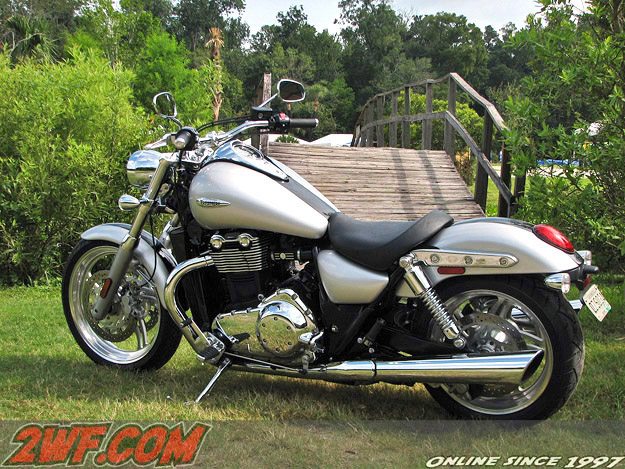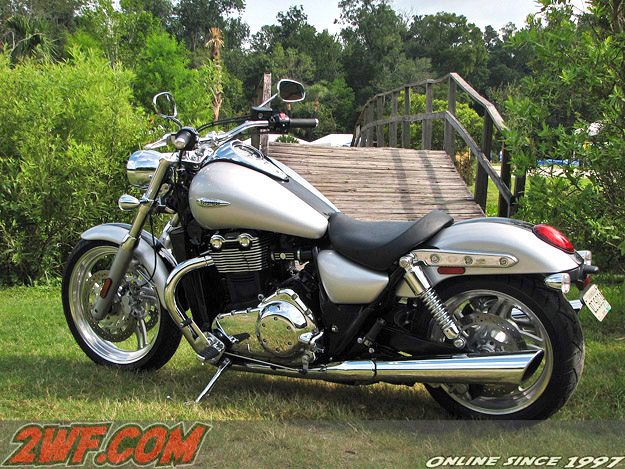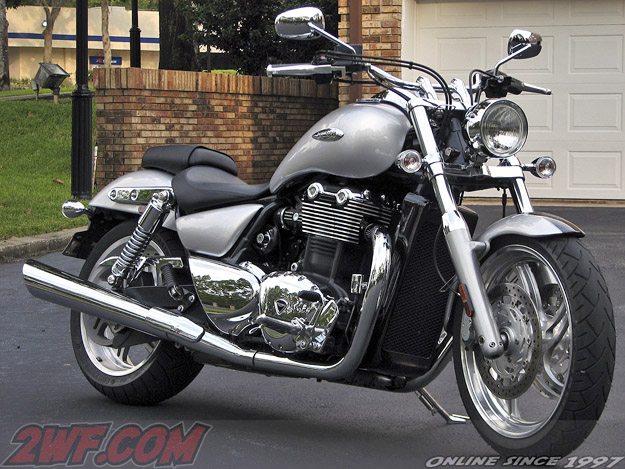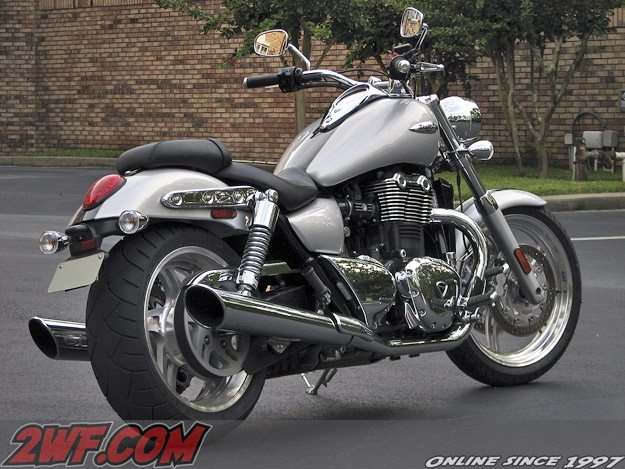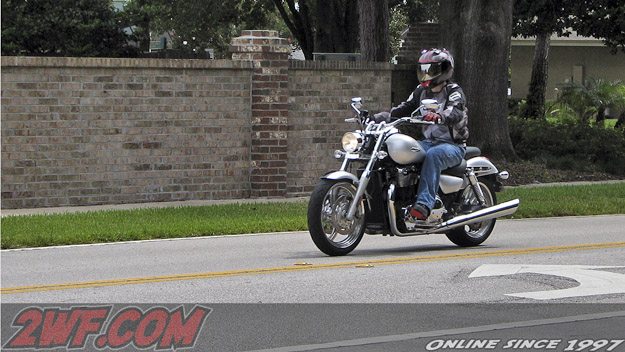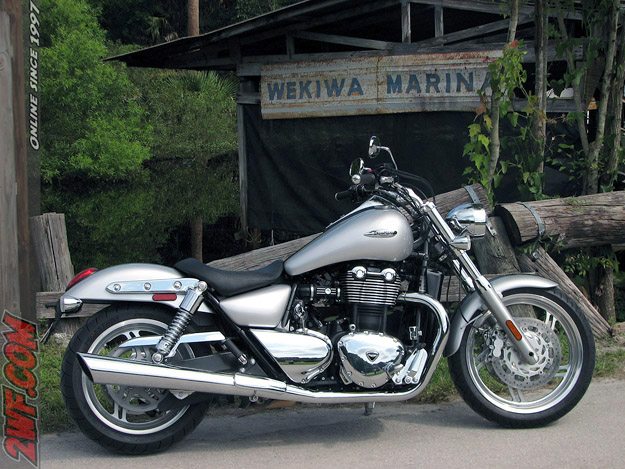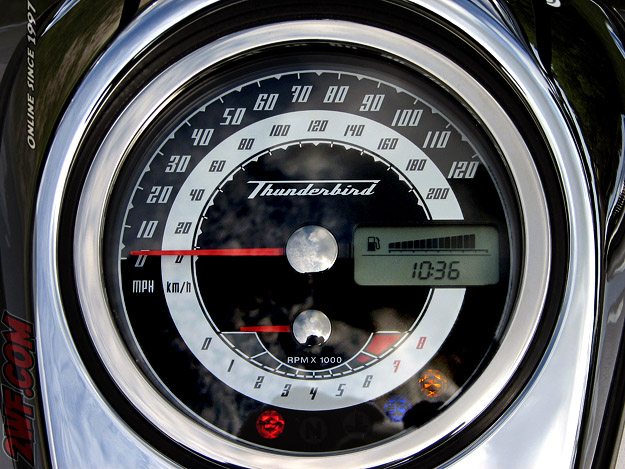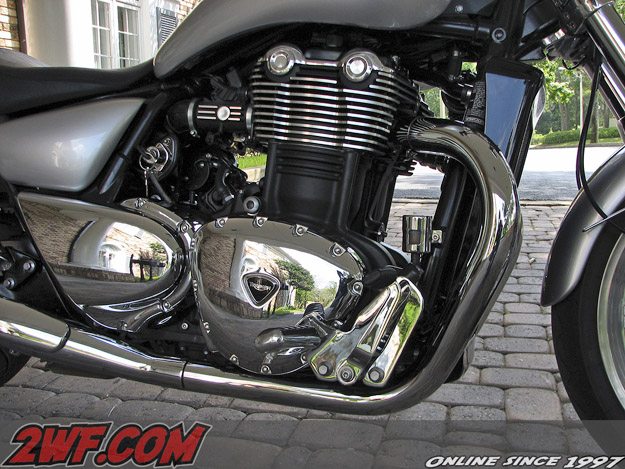Wide open two-lane highways stretching out into the distance.
Tree covered roads meandering through small towns.
Winding country lanes cutting a scenic path beside a stream. Main Street USA on a Saturday night.
All these places are the domain of that distinctly American of bikes, the cruiser.
But not just any cruiser will do, mind you. Only the biggest, baddest bikes need apply here.
Got less than 1200cc? Got more than 2 cylinders? Either way, brother, you don’t fit in and you’re not wanted so go play in the sandbox.
It seems that Triumph finally got tired of having sand kicked in its face.
When Triumph called and asked me if I’d like to spend some time on their new 2010 Thunderbird I of course said “no”.
Haha…..just kidding. I, of course, said yes. Arrangements were made and I dropped off the Daytona 675 and picked up a silver (with black stripe) Thunderbird.
Once I got over the 400 pound vs. 700 pound bike and the sportbike-to-cruiser transition, I was ready to give it a good preliminary once over. Out came the magnifying lens and the fine-tooth comb. OK, so now that the splinter is out of my finger and my hair looks good lets go over the bike shall we?
The first thing I noticed was that the bike looks smaller than it is. I’m not sure how Triumph pulled off this optical illusion but, until you are either standing right next to it or sitting on it, the T-bird seems more compact than a 1600cc bike should.
This was proven when my wife, who has never ridden a motorcycle in her life, took one look at the T-bird and said “that looks like a bike that I could ride”. Yeah……no.
The quality of paint is right up there with Harley standards, which is really spectacular. The silver paint had a lot of metallic in it so it really caught the light nicely while the black stripe and pinstripes are laid under the clear coat. I saw no evidence of flaws of any kind in any of the paint. Now normally I’m not that picky on paint jobs but on a cruiser the paint (and paint colors) are an integral part of the experience.
Another very important part of the cruiser experience is fit and finish. A sportbike can get away with using cheap plastic parts in the name of saving weight; a cruiser cannot.
Once again Triumph has hit the nail on the head and created a bike that just feels right. I let a die-hard Harley rider (that is all he has ever owned) ride the T-bird and when he came back (he had to as I had the keys to his $20k Road Glide) he was grinning ear to ear and his first word was “wow!”. He felt that the T-bird was a bike that he might actually consider buying as it felt “very well put together. Very solid”.
As if that wasn’t enough he then told another old Harley riding buddy that he should go out and look at the Thunderbird as it was a great bike. Now if you can get a dyed-in-the-wool Harley fanatic to recommend your bike to one of his buddies, you’ve done something right.
Triumph placed the speedometer and gauge cluster in the now traditional place on top the gas tank. I for one am not a big fan of this placement as it requires you to take your eyes completely off the road ahead but if Triumph didn’t put it there the potential customers would have complained.
Triumph did go a couple of steps beyond the “cruiser standard” though but not only adding a tachometer integrated into the speedometer’s face but an LCD that shows a digital fuel gauge plus; clock, 2 trip meters, odometer, and range to empty. All of those functions can be accessed through a button on the right handlebar beneath the engine cut-off switch.
Another nice feature of the T-bird are the…..wait for it……….self-canceling turn signals! I know — exciting, right? Why every bike doesn’t have this feature I’ll never know as it can’t add that much weight and it sure does help. Besides keeping you from looking foolish as you ride down the road with a turn signal flashing, it’s also a safety feature.
We all know that the heart and soul of any motorcycle is the motor and Triumph took the whole American “super-size me” craze to heart here.
Understanding that most cruisers are V-twins and also understanding that; A) They knew nothing about building a V-twin; and B) Even if they wanted to learn, a bike with a big V-twin is NOT going to be looked at as a Triumph.
Keeping those two things in mind, Triumph decided to BE Triumph and built a 1600cc (1597cc to be exact) parallel twin. Not only does this motor fit the correct size bracket for a big bore cruiser; it also gets the award for “largest production parallel twin”.
Instead of going with the traditional 180- or 360-degree crank, Triumph built the T-bird’s with 270 degrees. This gives the bike a very unique sound while internal counter-balancers keep any inherent vibes at bay.
The bike is also liquid-cooled and somehow never feels like it is trying to cook you no matter how hot out it is or how much traffic you sit in. Those of you who have ridden a big displacement motor understand how impressive that feat is.
With 84.8 hp at 4,850 rpm and 107.7 ft.lbs at 2,750 rpm, the T-bird has enough punch to smoke a new Stage 1 kit (pipes, air filter, re-map) equipped Fat Boy by about 3 bike lengths from a dead stop to about 80 mph. Above that speed the better breathing Harley caught back up and would have passed if we had continued pushing the point.
The 1700 cc big-bore kit is supposed to be an entirely different animal so we’ll let you know how that changes the bike’s demeanor when we get our hands on one.
One of the most impressive stats on this motor isn’t found in the spec sheet though. That is the all-important MPG figure.
I was very surprised to actually find that even though I rode the bike much, much harder than most of its intended operators probably would, I still managed to get right around 47 MPG. That is pretty impressive for a motor in this size range and a figure that I’m sure is going to be hard to beat in this class.
A set of pipes, a re-map, and a less restrictive air filter would do the trick nicely as the T-bird does start to run out of steam at around 5,000rpm; a whole 1,500rpm before redline.
Part of the problem may also be that the T-bird is a “Butt Breather”. Yep the air box is located under the rider’s seat and breathes through two intake tracks molded to the seat bottom and facing towards the rear (of the bike not the rider).
Now it appears to me that the bottom of the air box is suspended over open air and seeing as how the air filter is the oval type, a quick modification to the bottom of the air box and voila!; better air flow. Of course this is just me talking and this modification is in no way sanctioned, endorsed, or looked upon kindly by Papa Triumph.
Do you like corners? Do you like grinding peg feelers into dust? If you answered yes to both of these questions the Thunderbird may be the bike for you!
While the peg feelers do touch down quite a bit earlier than I would prefer I only had one time where an actual hard-part dug in a lifted the bike off the pavement a bit. I actually got used to using the peg feelers almost like you would a set of knee sliders; plant them on the ground and use them to judge your lean angle.
The big tubular steel, twin spine frame exhibits almost zero torsional twisting while being shoved around in corners. I actually started riding the bike like a big feet forward standard instead of a cruiser; pushing the bike into corners much harder than a sane person (or the Thunderbird’s normal buyer) ever would.
Through it all I never felt the bike get out of shape or seem like it wasn’t happy with all the shenanigans. Push it hard and it just takes it and ask for more…..right up until there is a dip mid-corner that causes something hard and unmovable under the bike to slam into the ground thereby causing you, the rider, to need a change of underwear.
Other than that one incident the 2010 Thunderbird took everything I could throw at it, corner wise, like it was a normal day at the office. The average Thunderbird rider will have plenty of room should they find themselves going into a corner hotter than they wanted to.
Aiding in the Thunderbird’s ability to carve corners is the fact that Triumph didn’t go in for the current trend of sticking a tire on the rear that is big enough for a top-fuel dragster. Nope, Triumph went for the very sensible rear tire size of 200 mm in width which is about as big as you want to go without worrying about sacrificing any handling. For you spec freaks out there Triumph offset the 32 degrees of rake with a whopping 151.3 mm of trail.
While the suspension works great when the road gets twisty, it has an issue over hard-edged bumps if you weigh less than, say, 210 pounds.
I had the rear preload set all the way down on 1 and the bike was one step above a rigid over any type of bump that required the suspension to compress quickly. Now granted at 180 pounds I may not be the typical size of most cruiser riders but I’m no 135 pound lightweight either.
To my way of thinking, the rear shocks should be set at 3 for a rider in the 200 pound range with the ability to move up and down as needed. I spoke with a Triumph salesperson who said they sold a Thunderbird to a guy that weighed 400 pounds and he only needed the preload set at 3 (out of 5). Too stiff rear shocks are the one buzz kill on the bike and one that really could have been avoided by Triumph.
If you look at most cruisers built today it seems that the trend is to get away with as little in the way of brakes as possible. What other reason could there be for building 700+ pound bikes with only a single front rotor?
Weight savings? Aerodynamics? Apparently Triumph feels that if they are going to build a bike that goes and corners well it should also stop well regardless of what other manufacturer’s think.
Up front on the Thunderbird you’ll find not one but two 310 mm floating rotors being squeezed by Nissin 4-piston fixed calipers.
Now a little birdie told me that these were pulled from the the old Daytona 955i parts bin but this is strictly hearsay and has not been confirmed by Triumph; they sure do look like it though.
You’ll find an identically sized rotor on the rear being squeezed by a Brembo 2-piston caliper. Yes — I too think it is strange that there are Nissins up front and a Brembo in the rear — but that is what is said on the spec sheet.
Overall stopping power is better than any cruiser I’ve ridden but a strong right hand is needed to capitalize on that power. Initial bite is somewhat weak and vague although for the Thunderbird’s intended purpose they work fine. Start pushing the bike though and you’ll wish for a little more bite and feedback from the Nissin calipers. Methinks a re-valve on the master cylinder would see this set straight.
Motorcycle transmissions fall into two categories; noticeable because they work well or noticeable because they don’t. Happily the Thunderbird’s is in that first category.
First-to-second shifts, if attempted under 2,500 rpm, will give you the big, heavy flywheel thunk but are smooth as can be above 2,500 rpm, as are all other shifts. I’m beginning to get bored with Triumph’s transmissions as there is hardly anything to really report on.
Just like their transmissions, Triumph’s fuel injection system just plain works great and is one that other manufacturers need to study. Big bike, small bike, newly designed bike or not, they all work almost flawlessly. Quite boring actually. A little popping, surging, or acting goofy once in a while would be nice……I’m beginning to feel like the Maytag repairman talking about the F.I. system!
One of the most important features that cruiser buyers look at is the seating position. Is it comfortable and does it have the right attitude?
This is an area where the Thunderbird shines. Wide, flat bars sit exactly where most riders are going to be comfortable and keep you in an upright position instead of the “cruiser slouch”. You can adopt the “cruiser slouch” at any time but the bike doesn’t force you into it all the time.
The footpegs are in the obligatory forward position but are not so far forward that shorter riders will need to stretch just to touch them or so far back that taller riders feel like they are kissing their knees. Just like Baby Bear’s porridge, the pegs are just right for most people.
My time spent with the 2010 Triumph Thunderbird brought a couple of things to light:
1) I still like cruisers.
2) I really like this cruiser.
3) Triumph did a bang-up job on their first big bore, twin cylinder cruiser. They have easily built a bike that can and will serve notice to Harley that they aren’t the only “historical” brand in the big cruiser market any longer (even though Triumph swears this isn’t their intention).
4) I’d like mine in the blue and white with the 1700cc kit and short pipes, please.
Publication Date: January 2010
More Triumph Motorcycles:
| 2010 Triumph Thunderbird Specifications |
|---|
| Engine |
| Engine Type: Liquid-cooled, DOHC, Parallel-twin, 270º firing interval. |
| Capacity: 1597 cc (98.0 Cubic Inch) |
| Bore/Stroke: 103.8 mm x 94.3 mm |
| Compression Ratio: 9.7:1 |
| Fuel System: Multipoint sequential electronic fuel injection, progressive linkage on throttle. |
| Transmission |
| Primary Drive: Gear |
| Final Drive: Toothed Belt |
| Clutch: Wet, multi-plate |
| Oil Capacity: 4.2 liters (1.1 US Gallons ) |
| Gearbox: 6-speed constant mesh, helical type |
| Chassis, Suspension and Brakes |
| Frame: Tubular Steel, twin spine. |
| Front Suspension: Showa 47mm forks, 120mm travel. |
| Rear Suspension: Showa chromed spring twin shocks with 5 position adjustable preload, 95mm rear wheel travel. |
| Front Brakes: Twin 310mm floating discs. Nissin 4-piston fixed calipers. |
| Rear Brake: Single 310mm fixed disc. Brembo 2-piston floating caliper. |
| ABS: Optional Dual-channel ABS. |
| Instruments and Lights |
| Tank mounted instruments assembly with large speedometer and integrated tachometer. Includes LCD to display Odometer, Trip 1, Trip 2, Fuel Gauge, Range-to-empty & Clock. Integrated instrument scroll button on handlebars. |
| Display: Clock / Trip 1 / Trip 2 / Odometer / Fuel Gauge / Range to Empty |
| Warning lights: Indicators / High Beam / Neutral / EMS / Fuel / Oil Pressure / Alarm / Water Temp |
| Headlight: H4 60 / 55W, single reflector |
| Rear Light: LED |
| Indicators: Clear-lens, self-cancelling. |
| Wheels and Tires |
| Front Wheel: Cast aluminum alloy 5-spoke 19 x 3.5 inch. |
| Rear Wheel: Cast aluminum alloy 5-spoke 17 x 6 inch. |
| Front Tire: 120 / 70 R19 Metzeler Marathon ME880 |
| Rear Tire: 200 / 50 R17 Metzeler Marathon ME880 |
| Dimensions, Weights and Capacities |
| Length: 234.0 cm (92.1 inch). |
| Width (Handlebars): 88.0 cm (34.6 inch). |
| Height: 1120 mm (44.1 inch) |
| Seat Height: 700 mm (27.6 inch) |
| Wheelbase (mm/inch): 1615 mm (63.6 inch) |
| Fuel Tank Capacity: 22 liters (5.8 US Gallons) |
| Vertical Ground Clearance: 140 mm 5.5 inch |
| Dry Weight: 308 kg (678 lbs) |
| Wet Weight: 339 kg (746 lbs with full tank of fuel) |
| Performance (Measured at crankshaft to 95/1/EC) |
| Maximum Power: EC1 86.0 PS / 84.8 bhp / 63.2 kW @ 4850 rpm Maximum Torque: EC1 146.1 Nm / 107.7 ft.lbf @ 2750 rpm |
| Colors |
| Jet Black, Pacific Blue / Fusion White, Aluminum Silver / Jet Black |
| Price |
| $12,499 (ABS version $13,299) |
Owner Comments and Feedback
See details on submitting comments.
From “P.W.” (October 2011): “I just read the Triumph Thunderbird 1600 review on your website. What a really refreshing, entertaining and informative review. I have a Thunderbird with short loud pipes and hi-flow air filter and it’s by far the best bike I’ve ever owned (and I’ve had a few). Performance is more than adequate for the type of bike it is and the handling is perfection. Build quality is stunning, but then as a Brit, I’m slightly biased I suppose. Thanks to Kenn for a brilliant job!”
From “M.Z.” (3/10): “Great review of the Triumph Thunderbird. Fun to read. Informative and objective. Made me wish the article never ended.”
From “D.C.” (2/10): “What a nice bit of engineering the Thunderbird is. I could not resist having one myself and have not looked back from then on. So much power unbelievable and the ride is out of this world you will not be disappointed, take it from me.”
From “R.K.” (1/10): “I am very impressed with what I have read about the Thunderbird. If I were shopping for a new cruiser today, that bike would be at the top of my short list.
But that it not why I am writing — I could not help but notice the “Wekiva Marina” sign in the background of the 5th picture. I used to live in that area and I was saddened when the place burned. I am guessing by the black drape below the sign in that shot that it has never been renovated and re-opened. It was a great, scenic place to eat about a dozen years ago. Thanks for the memory!


